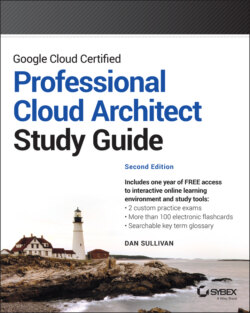Читать книгу Google Cloud Certified Professional Cloud Architect Study Guide - Dan Sullivan - Страница 15
What Does This Book Cover?
ОглавлениеThis book covers the topics outlined in the Professional Cloud Architect exam guide available here:
cloud.google.com/certification/guides/professional-cloud-architect
Chapter 1: Introduction to the Google Professional Cloud Architect Exam This chapter outlines the exam objectives, scope of the exam, and case studies used in the exam. One of the most challenging parts of the exam for many architects is mapping business requirements to technical requirements. This chapter discusses strategies for culling technical requirements and constraints from statements about nontechnical business requirements. The chapter also discusses the need to understand functional requirements around computing, storage, and networking as well as nonfunctional characteristics of services, such as availability and scalability.
Chapter 2: Designing Solutions to Meet Business Requirements This chapter reviews several key areas where business requirements are important to understand, including business use cases and product strategies, application design and cost considerations, systems integration and data management, compliance and regulations, security, and success measures.
Chapter 3: Designing Solutions to Meet Technical Requirements This chapter discusses ways to ensure high availability in compute, storage, and applications. It also reviews ways to ensure scalability in compute, storage, and network resources. The chapter also introduces reliability engineering.
Chapter 4: Designing Compute Systems This chapter discusses Compute Engine, App Engine, Kubernetes Engine, Anthos, and Cloud Functions. Topics in this chapter include use cases, configuration, management, and design. Other topics include managing state in distributed systems, data flows and pipelines, and data integrity. Monitoring and alerting are also discussed.
Chapter 5: Designing Storage Systems This chapter focuses on storage and database systems. Storage systems include object storage, network-attached storage, and caching. Several databases are reviewed, including Cloud SQL, Cloud Spanner, BigQuery, Cloud Firestore, and Bigtable. It is important to know how to choose among storage and database options when making architectural choices. Other topics include provisioning, data retention and lifecycle management, and network latency.
Chapter 6: Designing Networks This chapter reviews VPCs, including subnets and IP addressing, hybrid cloud networking, VPNs, peering, Shared VPCs, and direct connections. This chapter also includes a discussion of regional and global load balancing. Hybrid cloud computing and networking topics are important concepts for the exam.
Chapter 7: Designing for Security and Legal Compliance This chapter discusses IAM, data security including encryption at rest and encryption in transit, key management, security evaluation, penetration testing, auditing, and security design principles. Major regulations and ITIL are reviewed.
Chapter 8: Designing for Reliability This chapter begins with a discussion of Cloud Operations (formerly Stackdriver) for monitoring, logging, and alerting. Next, the chapter reviews continuous deployment and continuous integration. Systems reliability engineering is discussed, including overloads, cascading failures, and testing for reliability. Incident management and post-mortem analysis are also described.
Chapter 9: Analyzing and Defining Technical Processes This chapter focuses on software development lifecycle planning. This includes troubleshooting, testing and validation, business continuity, and disaster recovery.
Chapter 10: Analyzing and Defining Business Processes This chapter includes several business-oriented skills including stakeholder management, change management, team skill management, customer success management, and cost management.
Chapter 11: Development and Operations This chapter reviews application development methodologies, API best practices, and testing frameworks, including load, unit, and integration testing. The chapter also discusses data and systems migration tooling. The chapter concludes with a brief review of using Cloud SDK and programmatically working with GCP.
Chapter 12: Migration Planning This chapter describes how to plan for a cloud migration. Steps include integrating with existing systems, migrating systems and data, license mapping, network management and planning, as well as testing and developing proof-of-concept systems.
Like all exams, the Professional Cloud Architect certification from Google is updated periodically and may eventually be retired or replaced. At some point after Google no longer offers this exam, the old editions of our books and online tools will be retired. If you have purchased this book after the exam was retired, or are attempting to register in the Sybex online learning environment after the exam was retired, please know that we make no guarantees that this exam’s online Sybex tools will be available once the exam is no longer available.
